
At the end of last summer, we threw out most of our backyard patio furniture. We called a gardener friend, and he helped us plot out some space to plant some shrubs and flowers that would grow in shady areas.
This summer, the plan is to get new patio furniture, tend to those shrubs, and make our backyard a more welcoming and attractive space. It’s been a process.
Can you guess how my backyard improvement story applies to the writing process?
Revision Is a Process
You could say we are in the process of revising our backyard space. We’re making changes, some bigger and some smaller, to make it more suitable for fulfilling its purpose: to provide an area that invites relaxation and fun times with friends and family.
We don’t have a lot of space to work with, but we want to use what we have in the best way we can. Painting my flowerpots will help, but that minor change won’t be enough.
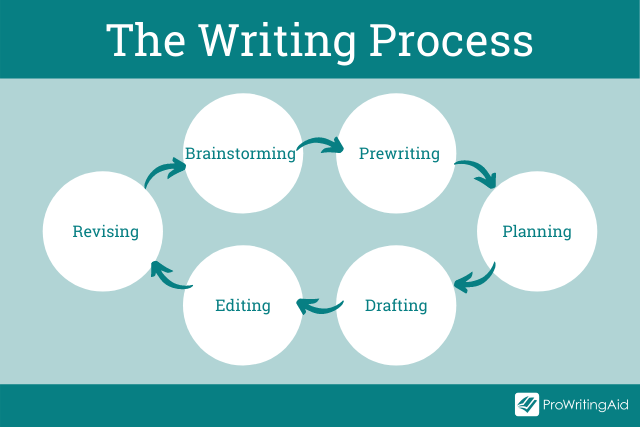
You should engage in active revision for all of your work. As much as we want them to be, first drafts are just not going to be our best products. They probably aren’t terrible, and might even be functional (like my few remaining backyard chairs), but they aren’t the best they can be and don’t fully achieve our purpose.
And just like my yard needs more than repainted flowerpots, revision of your written work involves more than just changing a punctuation mark or a spelling error.
The revision stage is an important part of the writing process. It’s where you take your work from good to great, making it the best it can be and ensuring the work achieves its purpose.
Step 1: Review Your Audience
Who Is Your Audience? What Are They Looking for in Your Work?
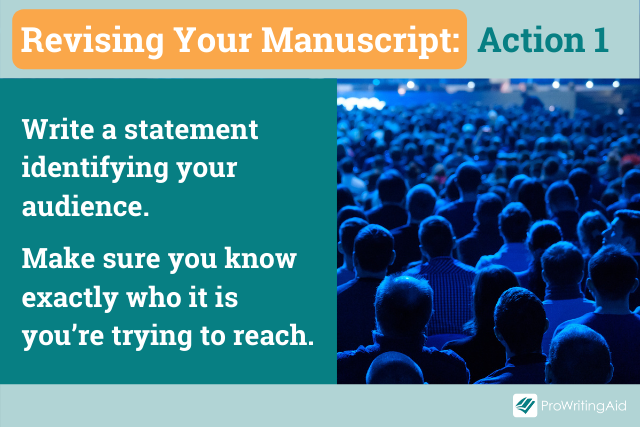
Whether you’re writing an academic essay or online content or a personal essay, you need an engaging introduction that catches your readers’ attention. However, the length and substance of your intro will change depending on your overall purpose and audience.
Additionally, body paragraphs need to be organized. You need to move smoothly from one point to the next, keeping the paragraphs cohesive. As with your introductions, the length, style of development, and word choice of those body paragraphs will be different depending on purpose and audience.
You’ll also need a conclusion providing a strong final comment that echoes with your readers. Again, that final comment will change depending on your audience. Are you writing for academics? Potential customers? A larger general population you are trying to convince of an argument?
Step 2: Review Your Purpose
What’s Your Purpose? What Goals Are You Trying to Achieve in Your Piece?
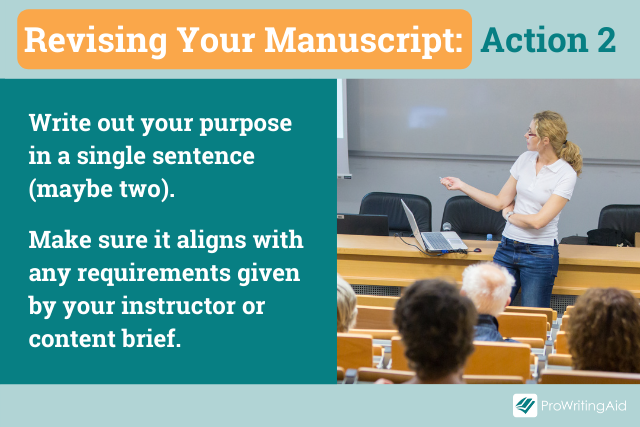
Your audience is directly connected to your purpose. Why are you writing? Were you given an assignment to compare and contrast two literary works or argue a debatable issue? Are you selling an experience or a product? Are you sharing a meaningful, personal story?
By focusing on the purpose, you’ve created a target for yourself. You’ve probably heard the Hilary Hinton “Zig” Ziglar quote “If you aim at nothing, you’ll hit it every time.”
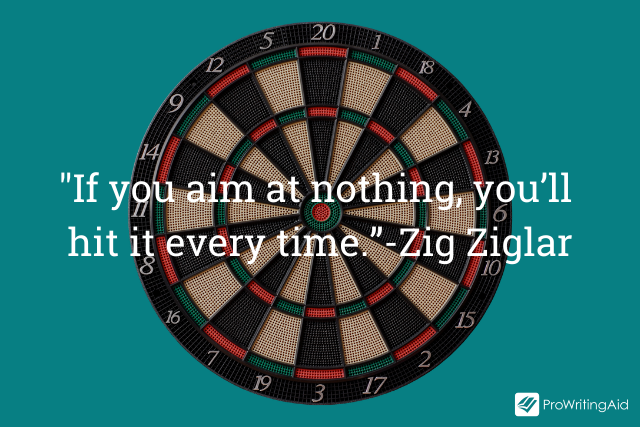
It’s hard to evaluate your work if you don’t know what the purpose, or target, of that work is in the first place.
Your purpose, like your audience, will shape the tone, language, and style of your writing.
For example:
If you’re writing to promote a vacation spot, you’ll need to include specific details highlighting why your readers should “book now!”
If you’re writing an essay about how special it was to eat dinner at grandma’s house, you should include sensory details that immerse your readers in the experience of grandma’s house.
If you’re comparing and contrasting two of Shakespeare’s plays, your readers don’t need to smell what Shakespeare ate or drank as he wrote or navigate pitches to buy texts of the plays!
I’m not trying to get my backyard into an issue of Better Homes and Gardens. My backyard audience is friends and family who like to eat, drink, and talk. Therefore, my purpose is to create a welcoming space that invites eating, drinking, and talking among friends, and I’m focusing my backyard revision process on hitting that target.
What Makes Good Writing? What Does All Good Writing Have in Common?
Good writing includes these traits, whatever its purpose:
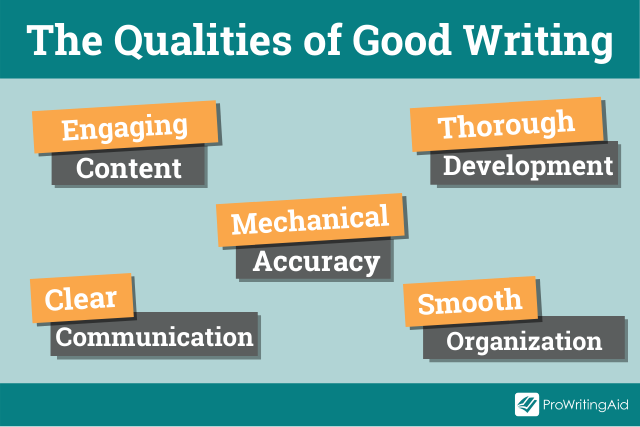
Clear Communication: your writing needs to communicate its message clearly. This clarity refers to the piece overall, as well as its individual sentences and ideas.
Smooth Organization: your writing needs to be organized. Ideas have to flow smoothly from one to the next so that the parts comprise a cohesive whole. Even in creative writing, where you may include time hops or scene changes, transitions and other organizational cues must work to maintain structure.
Thorough Development: your work needs to provide the details and discussion required for your readers to get your point. “Thorough” will look different depending on your purpose and audience. Some development may appear as bulleted lists of what a product can offer. Other development may include references to and quotes from literary works or extended discussion on why a certain opinion is worth considering.
Engaging Content: your work should keep your reader interested. Think about how you can incorporate creativity or personality or points of interest into whatever it is you’re writing. You might include personal stories, testimonials, sharp insights, or maybe a bit of humor. Of course, keep your audience and purpose in mind.
Mechanical Accuracy: Grammar, sentence structure, and punctuation matter. In fact, strong mechanics support all the other traits on this list! ProWritingAid makes this trait easy to achieve with the Realtime Report.
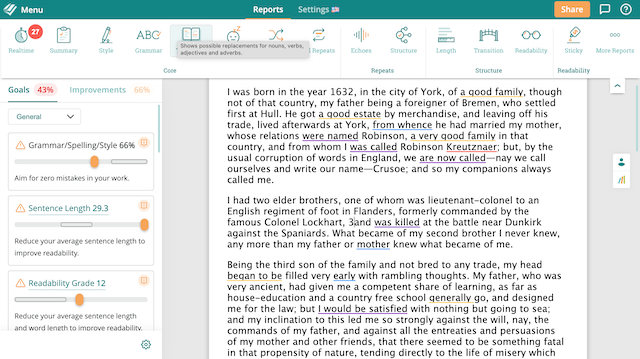
Step 3: Evaluate and “Collect Data” from Your Work
Before you change your draft, give it a thorough evaluation.
That’s what I had to do with my backyard. Once I had established the purpose for it, it was time to evaluate the extent to which its characteristics were fulfilling that purpose.

1. Introduction
- How do I grab my readers’ attention and make them want to read more?
- How clearly do I establish the purpose, or direction, for the piece (for an essay, this would be your thesis statement)?
- How did I organize the introduction? Is it one longer paragraph or several shorter paragraphs?
2. Body Paragraphs
- What’s the main point of each paragraph?
- How do I develop that main point?
- What transitions do I use to get from one idea to the next or one paragraph to the next?
3. Conclusion
- How do I conclude my piece?
- What strong final comment do I leave the audience to consider or reflect upon?
4. The Piece Overall
- What’s my overall tone?
- How well does the piece hold together?
- To what extent does it fulfill its purpose?
Step 4: Determine Where You Need to Take Action
You’ve collected a lot of data on your work now. You know what’s happening in your writing and I know what’s happening in my backyard:
- The furniture is shabby. The chairs are functional but have some rust and dirt I can’t remove.
- I don’t have tables. The large one broke, so we chucked it. There’s no place for guests to put down plates or cups.
- There’s no sense of order to the space overall.
- The flowerpots hold pretty flowers, but the pots are faded and unattractive.
- I’ve got a nice fire pit, but don’t know where to place it.
- There’s an awkward space between the grass and the fence.
- I have no umbrella or other shade-creator.
This data will help guide us as we plan revisions.
From my data, I see I need to make some general or big-picture changes. I need to reorganize my furniture plan, replace my old chairs, and add tables. I also need to attend to details, like replacing or upgrading those flowerpots. These changes will contribute to my purpose of inviting conversation and refreshment.
You’ll notice the same trends with your writing. You may need to make some big-picture organizational changes as well as specific changes to word choice or sentence structure, along with anything in between.
Literacy expert and teacher Kelly Gallagher created this easy-to-remember acronym to help writers take action where their work needs big- and small-picture changes:
- Replace vague or overused words, clichés, and awkward or unclear sentences
- Add more information or examples, description or descriptive words, transitions, and quotes
- Delete unnecessary sentences or unrelated ideas (even if they sound good!) and unwanted repetition
and
- Reorder ideas for a stronger sense of flow and unity
(adapted from Gallagher, Kelly. Write Like This Portland, ME, Stenhouse Publisher, 2011)
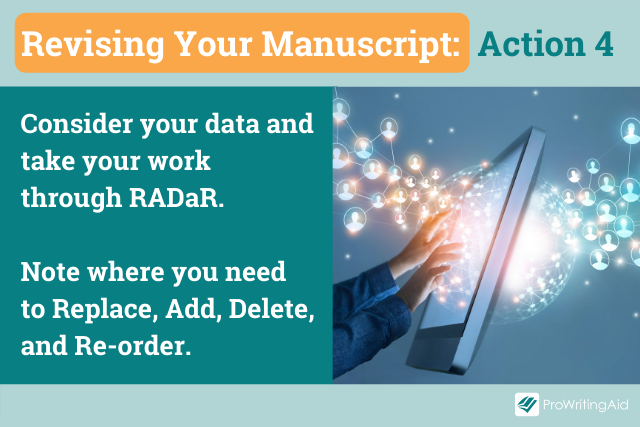
Step 5: “Re-Visioning”
Now that you’ve identified where changes are needed, determine how you will implement changes by re-imagining or “re-visioning” your work.
For example, for my backyard revision, I’ll have to decide what kind of table I’ll need—one big or several small? How many new chairs do I need and how will I organize them? How can I fill the gap between the grass and the fence.
Consider all of your reviews and evaluations so far, and make decisions about your writing.
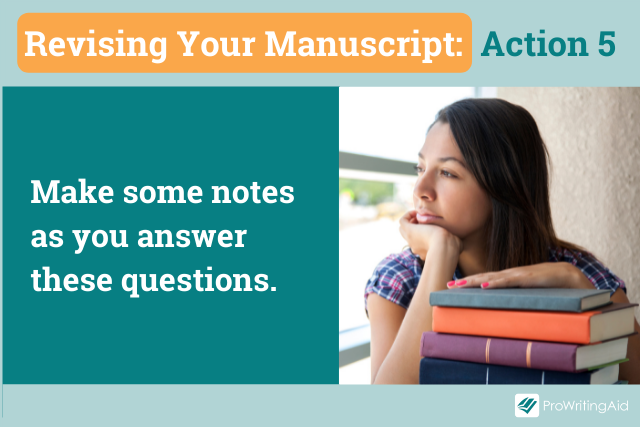
- What can I do to make my introduction more engaging and focused?
- How can I adjust my thesis statement to ensure my reader knows where my discussion is headed?
- What can I add to each body paragraph to make the main point more convincing or vivid or substantial?
- Where can I delete and/or replace dull, overused, vague, or just poorly chosen words or ideas?
- How can I reorder my paragraphs, or the details within my paragraphs, to create a better reading experience for my audience?
- What can I do to make my conclusion more creative or thought-provoking?
Step 6: Revise and Repeat

Once you’ve made your decisions, it’s time to revise your work. Put those decisions into action and rewrite your work. After that, go through the revision process again and maybe again. Take the time to make your work the best it can be!
Step 7: Proofread and Make Final Edits
Once you’re satisfied with the content and structure of your work, give it a good proofread and edit. Examine your work for those pesky little errors and missing punctuation. You can make this part really easy by letting ProWritingAid do the work for you! The reports will find errors and make suggestions for improvement.
Revision Is Part of the Writing Process
Sometimes, we don’t want to revise because we feel as though we are “done” once we’ve fulfilled a word count and added the period to the final sentence of our first draft. In her New York Times article “Revision and Life: Take it from the Top-Again”, Nora Ephron wrote:
“When I was in college, I revised nothing. I wrote out my papers in longhand, typed them up and turned them in. It would never have crossed my mind that what I had produced was only a first draft and that I had more work to do; the idea was to get to the end, and once you had got to the end you were finished…”
She learned that revision is necessary for good writing (and for life!)
Author Roald Dahl said, “Good writing is essentially rewriting. I am positive of this,” and Ernest Hemingway revealed he wrote the last page of A Farewell to Arms 39 times before he was satisfied (see theatlantic.com).
Thirty-nine times may not be realistic for all of us, but we can certainly manage a few passes through the revision process! The results are definitely worth it.
Writing is a process, and revision is an essential part of that process, not an “extra” part.
As writers, whatever we’re writing, we should work to produce our best: revision is how that happens.
If you want to talk more, come to my backyard—thanks to all the revisions, we can definitely hold a friendly conversation there now.



